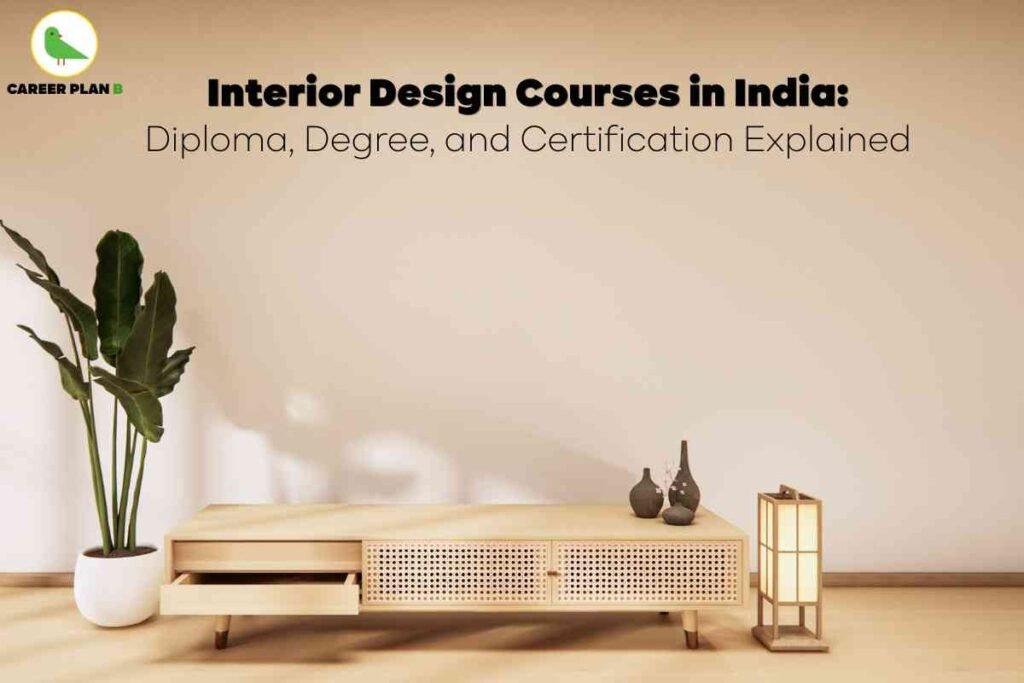Introduction
Interior design Courses in India is more than just style; it’s about transforming spaces with purpose, functionality, and creativity. With India’s booming real estate and lifestyle sectors, interior design is now one of the most exciting career choices for youth across the country. But with so many paths available, a common question arises: how many types of interior design courses in India, and which one is best for you?
Whether you’re a creative student after 10th or 12th, a graduate looking to specialize, or a professional seeking to upskill, India offers a range of interior design programs suited to every need. Let’s break down your options!
Why Learn Interior Design?
- Evergreen Demand: As housing and commercial development rise, skilled designers are always needed.
- Creative Fulfillment: Turn blank spaces into aesthetic, functional environments.
- Lucrative Careers: Salaries for designers in India typically start at ₹3–5 lakh per annum, with top designers and consultants earning significantly more.
- Freelance or Corporate: Flexibility to work with large firms, boutique studios, or independently.
Fact Table: Types of Interior Design Courses in India
| Course Type | Major Qualifications | Typical Duration | Key Providers |
|---|---|---|---|
| Certificate Courses | After 10th/12th | 3–12 months | Institutes/Online Platforms |
| Diploma Courses | After 10th/12th | 1–2 years | JD Institute, SPA, Samyak, etc. |
| Undergraduate Degree | 12th Pass (Some require PCM) | 3–4 years | NID, CEPT, JJ, Pearl, Srishti, etc. |
| Postgraduate Diploma | Graduate (Any discipline) | 1–2 years | Multiple colleges |
What Are the Main Types of Interior Design Courses in India?
India’s education system caters to diverse learning needs with different types of interior design courses:
1. Certificate Courses
- Duration: 3–12 months
- Level: Entry-level, suitable for beginners or hobbyists
- Focus: Basics of design, software skills, space planning, trends
- Eligibility: Usually after 10th or 12th grade
- Where Offered: Many private institutes and online platforms like Designer’s Class (NSDC), Samyak, etc.
- Fees: Typically ₹5,000–1,00,000
2. Diploma & Advanced Diploma Courses
- Duration: 1–2 years
- Level: After 10th/12th (with minimum 35–50% marks)
- Focus: Technical drawing, furniture layout, materials, color theory, CAD
- Certificate: Diploma in Interior Design, Advanced Diploma in Interior Design
- Popular Institutes: JD Institute, Sukriti Professional Academy, Samyak IT Solutions
- Fees: ₹35,000–1,45,000
3. Undergraduate Degree Programs
- Duration: 3–4 years full-time
- Types: Bachelor of Design (BDes), Bachelor of Science (BSc), Bachelor of Arts (BA), BArch
- Eligibility: 10+2 pass (Science or any stream—some require Math/Physics)
- Syllabus: Design principles, history, computer-aided design, materials, project work
- Top Colleges: Pearl Academy, National Institute of Fashion Technology (NIFT), Indian Institute of Art and Design (IIAD), and Amity University.
- Fees: ₹60,000–15,00,000 (varies widely)
4. Postgraduate Programs (PG Diploma/Master’s)
- Duration: 1–2 years full-time
- Types: MA, MSc, MDes, MBA, PG Diploma
- Eligibility: Bachelor’s in any discipline (with a minimum of 50–55% marks)
- Focus: Advanced technical skills, research, and management in design
- Fees: ₹20,000–4,00,000 (master’s), ₹40,000–3,50,000 (PG diploma)
How Does Interior Design Help You Get a Job?
- Diverse Career Paths: Interior designers, space planners, lighting specialists, set designers, furniture designers, project managers, and more.
- Industry Connections: Top programs offer internships, live projects, and placement support.
- Skill Development: Technical knowledge (software, drawing), client handling, and trend forecasting.
- Portfolio Boost: Most courses include practical assignments that build a solid design portfolio, crucial for getting hired.
FAQ
- What are the different types of space in interior design?
There are three main types of space:
- Positive space (occupied by objects or furniture)
- Negative space (empty or open areas around objects)
- Visual space (how space is perceived, including depth and openness)
Design balances these to create harmony and functionality.
- Which type of interior design do you like, traditional or modern?
Both have unique appeals: traditional design features classic elements, rich textures, and warm colors, while modern design emphasizes minimalism, clean lines, and neutral palettes. Preference depends on your taste—traditional feels timeless and cozy; modern is sleek and functional.
- What is the difference between interior design and interior decorating?
Interior design involves planning and creating functional, safe, and aesthetically pleasing spaces, including structural changes, space planning, and coordination of decor. Interior decorating focuses mainly on furnishing and styling a space without altering its structure.
- When you hear “luxury interior design,” what’s the first thing you think of?
Luxury interior design conjures images of high-quality materials, elegant and sophisticated aesthetics, bespoke furnishings, layered textures, ample space, and attention to detail, creating an exclusive, comfortable, and visually stunning environment.
- Is it worth doing interior designing in India?
Yes, interior designing is a growing and rewarding career in India with increasing demand in residential, commercial, and hospitality sectors. It offers creative fulfillment, good earning potential, and opportunities to work on diverse projects.
- I have no experience in interior design but I seem very interested in learning. What is/are the starting point(s) to learn more about it and practice interior design?
Start with basic online courses, books, and tutorials on design principles and software like AutoCAD or SketchUp. Practice by redesigning your space or helping friends. Build a portfolio through small projects, internships, or assisting professionals.
How Career Plan B Can Help
Confused about which type of interior design course in India is right for you?
We get it, choosing the best path can feel overwhelming, especially when you’re balancing your creative ambitions, career plans, budget, and the need to build in-demand skills that top employers want.
That’s where we step in!
Our career experts are ready to help you select the perfect interior design program, whether you’re just starting after school, considering a course change, or looking to upskill as a professional.
Get FREE personalised counselling today!
We’ll walk you through all the options: certificate, diploma, undergraduate, or postgraduate interior design course, and help you find the ideal fit based on your background, interests, and long-term dreams.
Contact Career Plan B Now. Take your first step towards a dynamic, creative career!
Conclusion
The interior design field in India is full of opportunities, and understanding the different types of courses available is the first step to building a successful creative career. From diplomas and certifications to bachelor’s and master’s degrees, there’s a course for every stage, whether you’re starting fresh or looking to upgrade your skills.
Take a moment to think about your current strengths and how you prefer to learn. When you’re ready, Career Plan B is here to guide you in picking the right interior design course and helping you shape a strong design portfolio.
👉 Visit careerplanb.co to explore how we can support your journey in the exciting and ever-evolving world of interior design.



